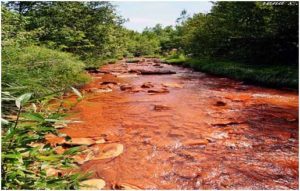Acid Mine Drainage
Water quality deterioration due to acid mine drainage has become a matter of grave concern and since, we are already facing major water crisis in various parts of India, poor quality surface water only adds to our woes.
The mine drainage water originating from collieries are highly acidic in nature and contain high hardness, sulphate, total dissolved solids and iron coupled with low pH values- which further results in contamination of trace (heavy) metals. Traces of such metals are highly toxic, undesirable and injurious to human health. Not just that, the quality of ground water gets deteriorated even more due to the percolation of low pH water into aquifers eventually ruining a large part of the water table due to ground water movement.
Acid Mine Drainage is formed by a series of geo-chemical and microbial reactions when water comes in contact with pyrite in metal ore or coal in the presence of oxygen.
The overall reaction of AMD formation is:
4 FeS2 + 14 H2O + 15 O2 → 4Fe (OH)3 + 8 SO42- + 16 H+ (Pyrite) + (Water) + (Oxygen) → “Yellow Boy” + Sulphuric Acid
Ferric Hydroxide precipitate commonly called as “Yellow Boy” gives the reddish brown color to the stream of water and the increase in acidity due to the formation of sulphuric acid.
However, since this is a multi-step reaction, the rate determining step in this case is the oxidation of Ferrous to Ferric ions in the presence of Thiobacillus Ferrooxidans (iron oxidizing bacteria).
Presently, all coal mines follow the conventional process of lime treatment in order to precipitate all the iron and increase the pH of the drainage. However, this treatment method has evidently been a failure in meeting the set discharge norms. The main reason behind this failure is the iron oxidizing bacteria which continue to reside in the treated water; gradually increasing the dissolved iron content, reducing the pH, increasing the risk of heavy metal contamination which leads to unfathomable distress to surface water.
Ozone serves as a great alternative to prevent such poor quality acid water from mixing into the rivers directly. Ozone being a very strong oxidant successfully removes iron from the mine water and also kills the iron oxidizing bacteria; due to its biocidal properties; which could degrade the quality of water at later stages. Apart from this, disinfection of water and other parametrical issues like turbidity, color and odor are also addressed by ozone. There is even a scope of reuse of such ozone treated water for industrial usage which will solve many of our water problems.
Such method has been tried at a Uranium Mine site in Brazil and has shown good results. Recently, an American company has announced the use of ozone technology for the treatment of Acid Mine Drainage in approximately 50,000 mining sites of North and South America.
The implementation of ozone treatment for AMD will help minimize the damage caused to the environment hence ensuring sustainable development for all.

